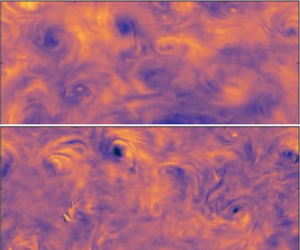Article contents
Supply mechanisms of the geostrophic mode in rotating turbulence: interactions with self, waves and eddies
Published online by Cambridge University Press: 13 September 2023
Abstract

Direct numerical simulations are performed in rotating turbulence for different regimes at various Rossby and inertial Reynolds numbers ( $\textit {Re}_I$). A new algorithm, adapted from stratified turbulence (Lam et al., J. Fluid Mech., vol. 923, 2021, A31) to rotating turbulence, permits to separate the three-dimensional velocity field into three parts: inertial waves (IWs), eddies and a geostrophic mode (GM). It uses the space–time properties of waves and their advection by the GM to filter the IWs from the rest of the motion. We obtain balance equations for the separate energies of waves, eddies and the GM. Their mutual interactions are evaluated and analysed via Sankey diagrams that provide a global picture of energy exchanges. When the flow is forced at large scale, it mainly feeds the wave part and the multiple interactions lead to energy dissipation in eddy and GM motion. We also show that, in addition to the wave/wave interaction that feeds the GM, corresponding to different mechanisms described in the literature, other non-documented interactions feed it, as the eddy/wave interaction or the eddy/eddy interaction at moderate
$\textit {Re}_I$). A new algorithm, adapted from stratified turbulence (Lam et al., J. Fluid Mech., vol. 923, 2021, A31) to rotating turbulence, permits to separate the three-dimensional velocity field into three parts: inertial waves (IWs), eddies and a geostrophic mode (GM). It uses the space–time properties of waves and their advection by the GM to filter the IWs from the rest of the motion. We obtain balance equations for the separate energies of waves, eddies and the GM. Their mutual interactions are evaluated and analysed via Sankey diagrams that provide a global picture of energy exchanges. When the flow is forced at large scale, it mainly feeds the wave part and the multiple interactions lead to energy dissipation in eddy and GM motion. We also show that, in addition to the wave/wave interaction that feeds the GM, corresponding to different mechanisms described in the literature, other non-documented interactions feed it, as the eddy/wave interaction or the eddy/eddy interaction at moderate  $\textit {Re}_I$. We propose a scale-by-scale analysis of the transfer to the GM: we show that transfers from wave or eddy occur at large scale, that they either inject or remove energy, and that this occurs with or without direct cascade depending on the kind of interaction, wave/wave, eddy/wave or eddy/eddy. The self-interaction of the GM is an inverse cascade for its horizontal component, shaping it into a very large-scale flow.
$\textit {Re}_I$. We propose a scale-by-scale analysis of the transfer to the GM: we show that transfers from wave or eddy occur at large scale, that they either inject or remove energy, and that this occurs with or without direct cascade depending on the kind of interaction, wave/wave, eddy/wave or eddy/eddy. The self-interaction of the GM is an inverse cascade for its horizontal component, shaping it into a very large-scale flow.
- Type
- JFM Papers
- Information
- Copyright
- © The Author(s), 2023. Published by Cambridge University Press
References
- 3
- Cited by



